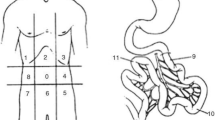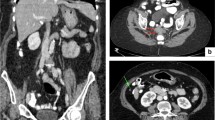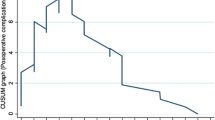Abstract
Purpose
To evaluate the accuracy of MDCT in the preoperative definition of Peritoneal Cancer Index (PCI) in patients with advanced ovarian cancer who underwent a peritonectomy and hyperthermic intraperitoneal chemotherapy (HIPEC) after neoadjuvant chemotherapy to obtain a pre-surgery prognostic evaluation and a prediction of optimal cytoreduction surgery.
Materials and methods
Pre-HIPEC CT examinations of 43 patients with advanced ovarian cancer after neoadjuvant chemotherapy were analyzed by two radiologists. The PCI was scored according to the Sugarbaker classification, based on lesion size and distribution. The results were compared with macroscopic and histologic data after peritonectomy and HIPEC. To evaluate the accuracy of MDCT to detect and localize peritoneal carcinomatosis, both patient-level and regional-level analyses were conducted. A correlation between PCI CT and histologic values for each patient was searched according to the PCI grading.
Results
Considering the patient-level analysis, CT shows a sensitivity, specificity, PPV, NPV, and an accuracy in detecting the peritoneal carcinomatosis of 100 %, 40 %, 93 % 100 %, and 93 %, respectively. Considering the regional level analysis, a sensitivity, specificity, PPV, NPV, and diagnostic accuracy of 72 %, 80 %, 66 %, 84 %, and 77 %, respectively were obtained for the correlation between CT and histology.
Conclusion
Our results encourage the use of MDCT as the only technique sufficient to select patients with peritoneal carcinomatosis for cytoreductive surgery and HIPEC on the condition that a CT examination will be performed using a dedicated protocol optimized to detect minimal peritoneal disease and CT images will be analyzed by an experienced reader.




Similar content being viewed by others
Abbreviations
- PC:
-
Peritoneal carcinomatosis
- PCI:
-
Peritoneal Cancer Index
- CRS:
-
Cytoreductive surgery
- HIPEC:
-
Hyperthermic intraperitoneal chemotherapy
- SE:
-
Surgical examination
- HE:
-
Histologic examination
References
Parkin DM, Bray F, Ferlay J, Pisani P (2005) Global cancer statistics, 2002. CA Cancer J Clin 55:74–108
Meyers MA (1973) Distribution of intra-abdominal malignant seeding: dependency on dynamics of flow of ascitic fluid. Am J Roentgenol Radium Ther Nucl Med 119:198–206
Seton-Rogers S (2013) Ovarian cancer: at the starting line. Nat Rev Cancer. doi:10.1038/nrc3510
Nougaret S, Addley HC, Colombo PE, et al. (2012) Ovarian carcinomatosis: how the radiologist can help plan the surgical approach. Radiographics 32:1775–1800. doi:10.1148/rg.326125511
Glehen O, Mohamed F, Gilly FN (2004) Peritoneal carcinomatosis from digestive tract cancer: new management by cytoreductive surgery and intraperitoneal chemohyperthermia. Lancet Oncol 5:219–228
Stewart JH 4th (2005) Shen P, Levine EA (2005) Intraperitoneal hyperthermic chemotherapy for peritoneal surface malignancy: current status and future directions. Ann Surg Oncol 12:765–777
Roviello F, Caruso S, Marrelli D, et al. (2011) Treatment of peritoneal carcinomatosis with cytoreductive surgery and hyperthermic intraperitoneal chemotherapy: state of the art and future developments. Surg Oncol 20:38–54. doi:10.1016/j.suronc.2010.09.002
Sugarbaker PH (1995) Peritonectomy procedures. Ann Surg 221:29–42
Sugarbaker PH (2009) Cytoreductive surgery and perioperative intraperitoneal chemotherapy for the treatment of advanced primary and recurrent ovarian cancer. Curr Opin Obstet Gynecol 21:15–24. doi:10.1097/GCO.0b013e32831f8f32
Roviello F, Pinto E, Corso G, et al. (2010) Safety and potential benefit of hyperthermic intraperitoneal chemotherapy (HIPEC) in peritoneal carcinomatosis from primary or recurrent ovarian cancer. J Surg Oncol 102:663–670. doi:10.1002/jso.21682
Jacquet P, Sugarbaker PH (1996) Clinical research methodologies in diagnosis and staging of patients with peritoneal carcinomatosis. Cancer Treat Res 82:359–374
Pfannenberg C, Königsrainer I, Aschoff P, et al. (2009) (18)F-FDG-PET/CT to select patients with peritoneal carcinomatosis for cytoreductive surgery and hyperthermic intraperitoneal chemotherapy. Int Ann Surg Oncol 16:1295–1303. doi:10.1245/s10434-009-0387-7
Limei Z, Yong C, Yan X, et al. (2013) Accuracy of positron emission tomography/computed tomography in the diagnosis and restaging for recurrent ovarian cancer: a meta-analysis. Int J Gynecol Cancer 23:598–607
Klumpp BD, Aschoff P, Schwenzer N, et al. (2012) Peritoneal carcinomatosis: comparison of dynamic contrast-enhanced magnetic resonance imaging with surgical and histopathologic findings. Abdom Imaging 37:834–842
Funicelli L, Travaini LL, Landoni F, et al. (2010) Peritoneal carcinomatosis from ovarian cancer: the role of CT and [1F]FDG-PET/CT. Abdom Imaging 35:701–707. doi:10.1007/s00261-009-9578-8
Kim HW, Won KS, Zeon SK, Ahn BC, Gayed IW (2013) Peritoneal carcinomatosis in patients with ovarian cancer: enhanced CT versus 18F-FDG PET/CT. Clin Nucl Med 38:93–97. doi:10.1097/RLU.0b013e31826390ec
Low RN (2007) MR imaging of the peritoneal spread of malignancy. Abdom Imaging 32:267–283
Roviello F, Marrelli D, Neri A, et al. (2006) Treatment of peritoneal carcinomatosis by cytoreductive surgery and intraperitoneal hyperthermic chemoperfusion (IHCP): postoperative outcome and risk factors for morbidity. World J Surg 30:2033–2040
Sant M, Allemani C, Santaquilani M, et al. (2009) EUROCARE-4. Survival of cancer patients diagnosed in 1995–1999. Results and commentary. Eur J Cancer 45:931–991. doi:10.1016/j.ejca.2008.11.018
Verwaal VJ, van Ruth S, de Bree E, et al. (2003) Randomized trial of cytoreduction and hyperthermic intraperitoneal chemotherapy versus systemic chemotherapy and palliative surgery in patients with peritoneal carcinomatosis of colorectal cancer. J Clin Oncol 21:3737–3743
Bijelic L, Jonson A, Sugarbaker PH (2007) Systematic review of cytoreductive surgery and heated intraoperative intraperitoneal chemotherapy for treatment of peritoneal carcinomatosis in primary and recurrent ovarian cancer. Ann Oncol 18:1943–1950
Hamilton T, Lanuke K, Mack LA, Temple WJ (2011) Long-term follow-up in the treatment of peritoneal carcinomatosis. Am J Surg 201:650–654
Sala E, Kataoka M, Pandit-Taskar N, et al. (2010) Recurrent ovarian cancer: use of contrast-enhanced CT and PET/CT to accurately localize tumor recurrence and to predict patients’ survival. Radiology 257:125–134
Satoh Y, Ichikawa T, Motosugi U, et al. (2011) Diagnosis of peritoneal dissemination: comparison of 18F-FDG PET/CT, diffusion-weighted MRI, and contrast-enhanced MDCT. AJR Am J Roentgenol 196:447–453
De Bree E, Koops W, Kroger R, et al. (2004) Peritoneal carcinomatosis from colorectal cancer or appendiceal origin: correlation of preoperative CT with intraoperative findings and evaluation of interobserver agreement. J Surg Oncol 86:64–73
Coakley FV, Choi PH, Gougoutas CA, et al. (2002) Peritoneal metastases: detection with spiral CT in patients with ovarian cancer. Radiology 223:495–499
Marin D, Catalano C, Baski M, et al. (2010) 64-Section multi-detector row CT in the preoperative diagnosis of peritoneal carcinomatosis: correlation with histopathological findings. Abdom Imaging 35:694–700. doi:10.1007/s00261-008-9464-9
Berger KL, Nicholson SA, Dehdashti F, Siegel BA (2000) FDG PET evaluation of mucinous neoplasms: correlation of FDG uptake with histopathologic features. Am J Roentgenol 174:1005–1008
Mazzei MA, Cioffi Squitieri N, Sani E, et al. (2013) Differences in perfusion CT parameter values with commercial software upgrades: a preliminary report about algorithm consistency and stability. Acta Radiol. doi:10.1177/0284185113484643.
Acknowledgments
We thank Ms. Julia Hassall for reviewing the English.
Author information
Authors and Affiliations
Corresponding author
Rights and permissions
About this article
Cite this article
Mazzei, M.A., Khader, L., Cirigliano, A. et al. Accuracy of MDCT in the preoperative definition of Peritoneal Cancer Index (PCI) in patients with advanced ovarian cancer who underwent peritonectomy and hyperthermic intraperitoneal chemotherapy (HIPEC). Abdom Imaging 38, 1422–1430 (2013). https://doi.org/10.1007/s00261-013-0013-9
Published:
Issue Date:
DOI: https://doi.org/10.1007/s00261-013-0013-9




